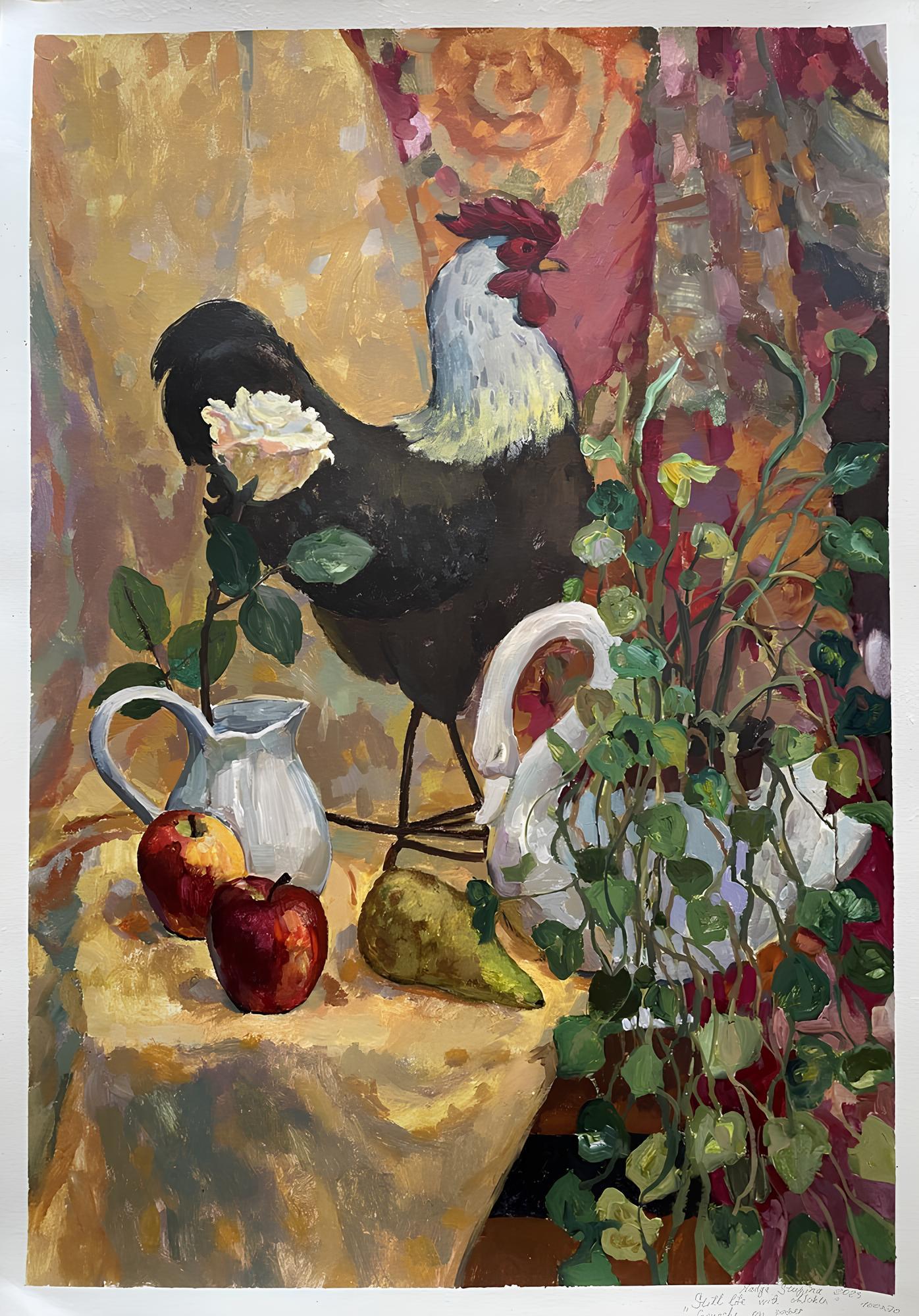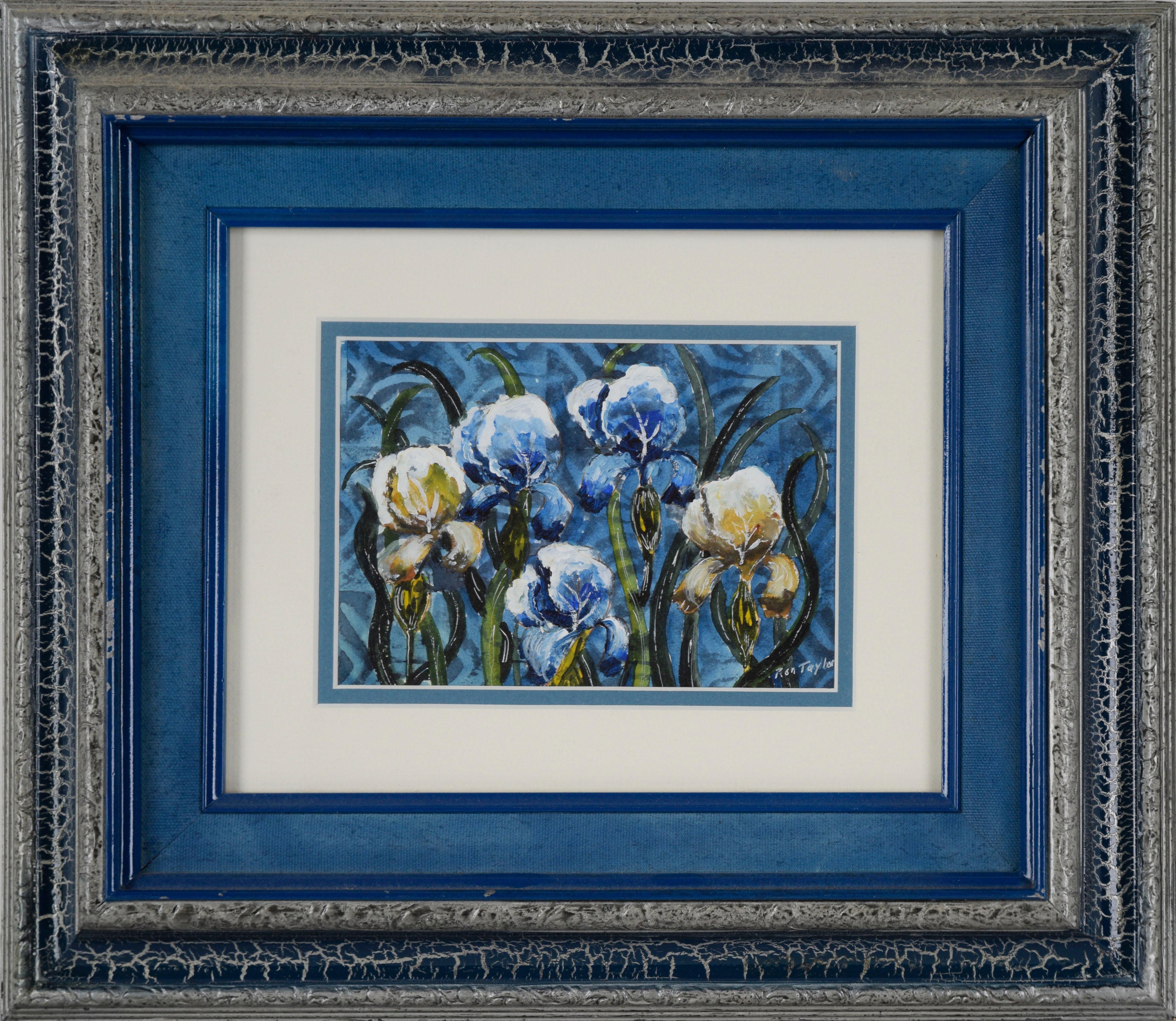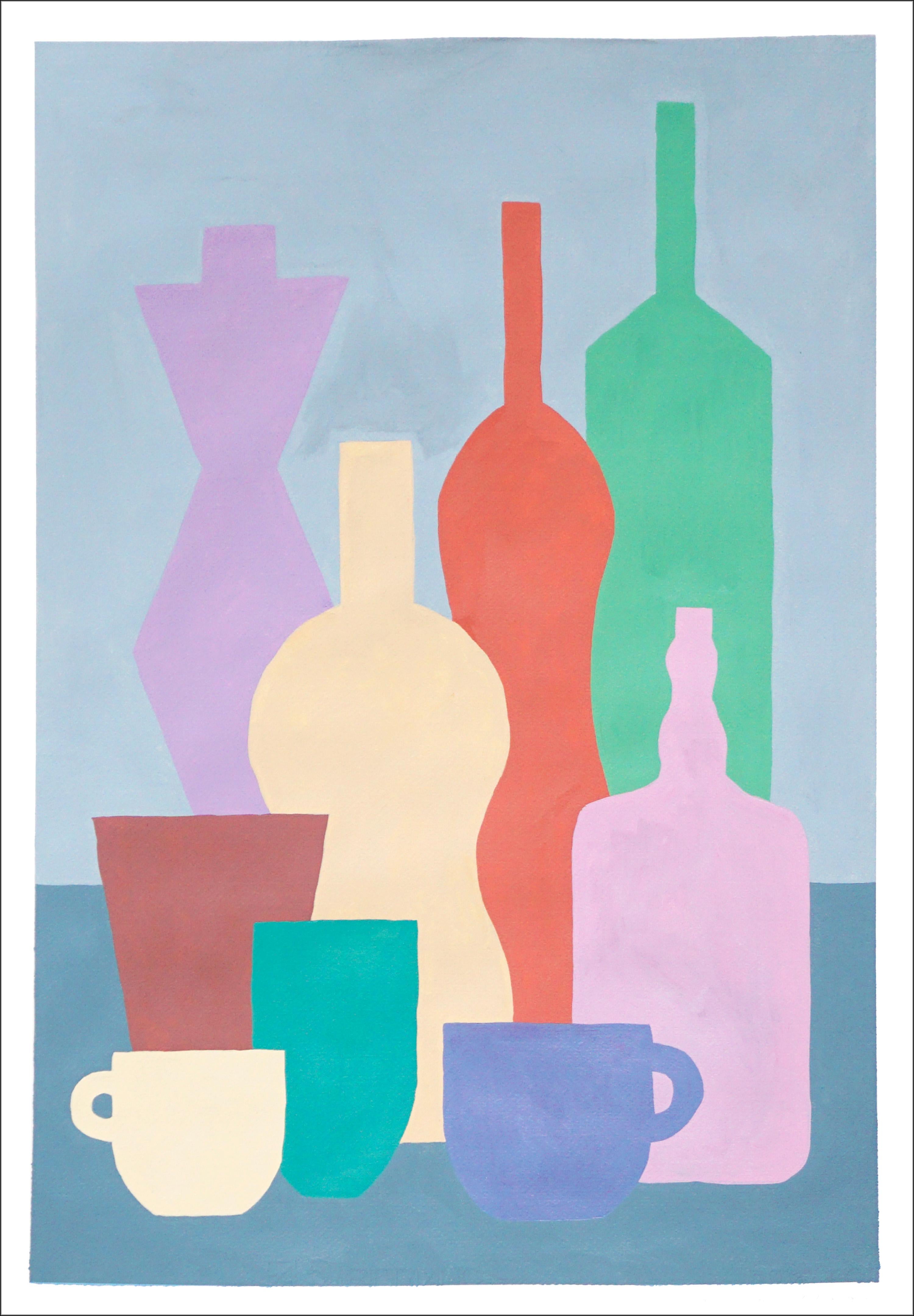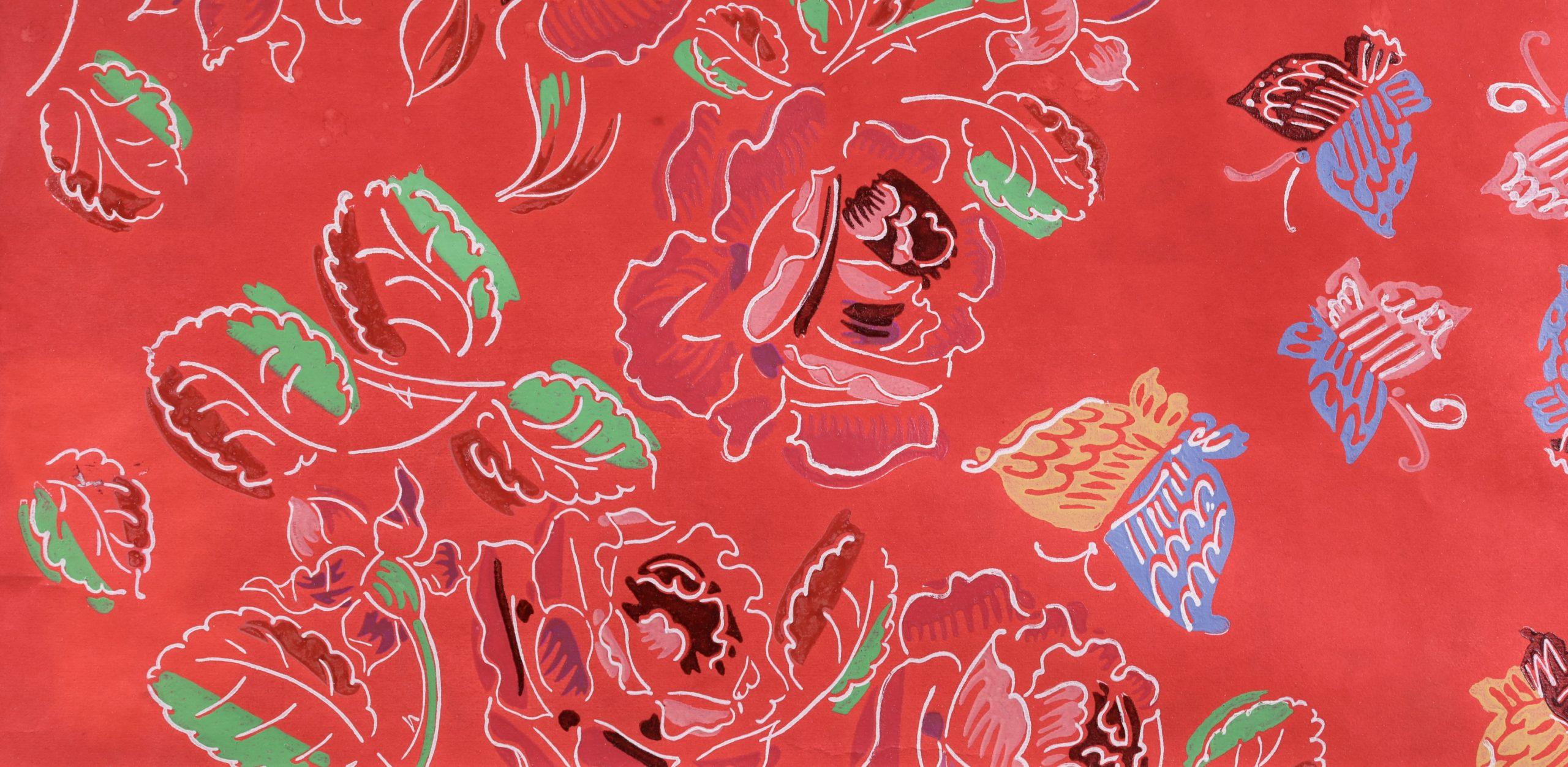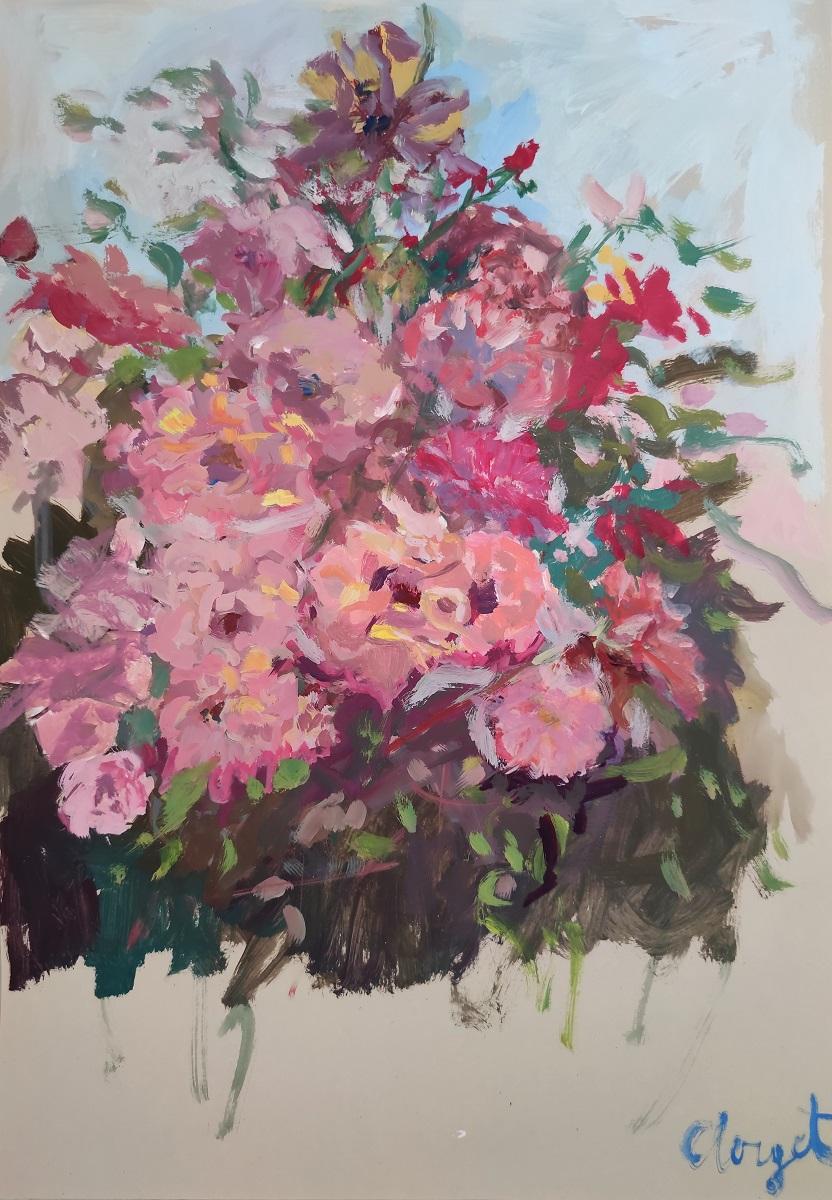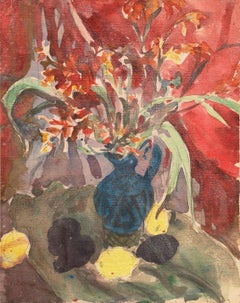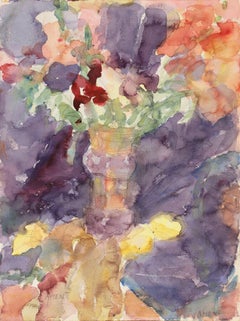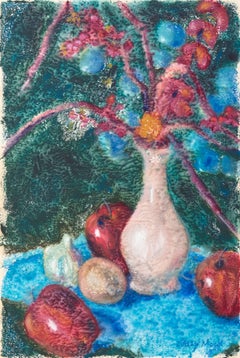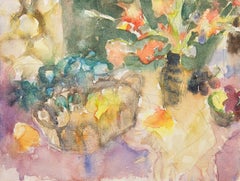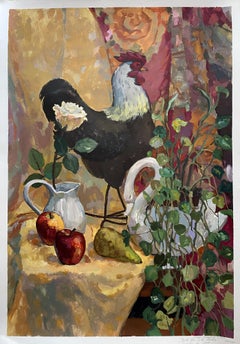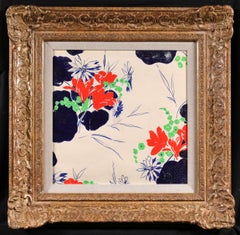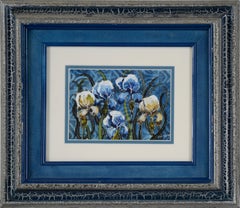Items Similar to 'Peaches in a Woven Basket', California Woman Artist
Want more images or videos?
Request additional images or videos from the seller
1 of 13
Leah Schwartz'Peaches in a Woven Basket', California Woman ArtistCirca 1965
Circa 1965
About the Item
Signed lower right, 'Leah Schwartz' (American, born 1920) and painted circa 1965.
A lyrical Modernist still-life showing three ripe peaches in a glazed earthenware bowl. An attractive, early work by this well-listed and exhibited Marin, California artist.
Accompanied by a first edition copy of 'Leah Schwartz:' (Hardcover, Strawberry Press, 1989) containing the artist's comprehensive biography and over 200 color illustrations of her work.
- Creator:Leah Schwartz (1920, American)
- Creation Year:Circa 1965
- Dimensions:Height: 15 in (38.1 cm)Width: 17.75 in (45.09 cm)
- Medium:
- Movement & Style:
- Period:
- Condition:minor toning; unframed. shows well.
- Gallery Location:Santa Cruz, CA
- Reference Number:1stDibs: LU344356042
About the Seller
5.0
Platinum Seller
Premium sellers with a 4.7+ rating and 24-hour response times
Established in 1982
1stDibs seller since 2013
720 sales on 1stDibs
Typical response time: <1 hour
- ShippingRetrieving quote...Shipping from: Santa Cruz, CA
- Return Policy
Authenticity Guarantee
In the unlikely event there’s an issue with an item’s authenticity, contact us within 1 year for a full refund. DetailsMoney-Back Guarantee
If your item is not as described, is damaged in transit, or does not arrive, contact us within 7 days for a full refund. Details24-Hour Cancellation
You have a 24-hour grace period in which to reconsider your purchase, with no questions asked.Vetted Professional Sellers
Our world-class sellers must adhere to strict standards for service and quality, maintaining the integrity of our listings.Price-Match Guarantee
If you find that a seller listed the same item for a lower price elsewhere, we’ll match it.Trusted Global Delivery
Our best-in-class carrier network provides specialized shipping options worldwide, including custom delivery.More From This Seller
View All'Still Life', Paris, Louvre, Salon D'Automne, Académie Chaumière, SFAA, LACMA
By Victor Di Gesu
Located in Santa Cruz, CA
Stamped verso with Victor Di Gesu (American, 1914-1988) estate stamp and painted circa 1955.
Winner of the Prix Othon Friesz, Victor di Gesu first attended the Los Angeles Art Cente...
Category
1950s Post-Impressionist Still-life Paintings
Materials
Paper, Watercolor, Gouache
'Irises', LACMA, MAM Paris, California Post-Impressionist Still Life
By Janet Ament De La Roche
Located in Santa Cruz, CA
A lyrical watercolor of flowers informally arranged in two vases and contrasted against a lilac and purple background.
Signed lower left and lower right, 'Ament' for Janet Ament De ...
Category
1950s Post-Impressionist Still-life Paintings
Materials
Paper, Watercolor
'Apples and Cherry Blossoms', Modernist Still Life
By Sally Mack
Located in Santa Cruz, CA
Signed lower right "Sally Mack" (American, 20th century) and painted circa 1975. Painted on Arches paper.
A vibrant, Post-Impressionist still-life showing branches of cherry-blossom...
Category
1970s Post-Impressionist Still-life Paintings
Materials
Gouache, Paper
'Still Life', Louvre, California Post-Impressionist, LACMA, Académie Chaumière
By Victor Di Gesu
Located in Santa Cruz, CA
Estate stamp, verso, for Victor di Gesu (American, 1914-1988) and painted circa 1955.
Winner of the Prix Othon Friesz, Victor di Gesu first attended the Los Angeles Art Center and t...
Category
1950s Post-Impressionist Still-life Paintings
Materials
Watercolor, Laid Paper, Graphite
'Still Life', School of Paris, Salon d’Automne, Académie de la Grande Chaumière
By Roger Derieux
Located in Santa Cruz, CA
Signed lower left, 'Roger Derieux' (French, 1922-2015) and painted circa 1960.
Born in Paris, Roger Derieux first studied at the Académie de la Grande Chaumière and, subsequently, ...
Category
1960s Post-Impressionist Still-life Paintings
Materials
Oil, Paper
'Still Life of Green and Black Grapes', Tokyo School of Fine Arts, Academy Award
Located in Santa Cruz, CA
Signed lower right in Kanji 'Sanzo' for Wada Sanzō 和田三造 (Japanese, 1883-1967) and dated 'Year 34' of the Showa Era, 1959 in the Gregorian calendar.
Artist, teacher and costume designer, Sanzo Wada worked during a turbulent time in avant-garde Japanese art and cinema. A multi-talented artist who gained early fame as a Western-style oil painter, his career spanned the late Meiji-era through the mid-twentieth century. In addition to numerous prizes and medals for his painting, he received the 1955 Academy Award for costume design for his work in the movie Gates of Hell. He also received awards for his pioneering work on color theory, which he researched and published in the 1920s and is still in use today.
Sanzo Wada graduated from the Western-style painting division of Tokyo School of Fine Arts. Studied in Europe 1907-1915; traveled to India and Burma. He was appointed a member of the Imperial Arts Academy in 1927 and taught at Tokyo School of Fine Arts from 1927.
According to Shinagawa Kiyoomi, editor-in-chief of the book of paintings in print "Dia Nihon Gyorui Gashuu" by Ohno Bakufu...
Category
1950s Post-Impressionist Still-life Paintings
Materials
Paper, Oil
You May Also Like
Still life with chicken
Located in Oslo, NO
In this painting, I infused the vitality of nature and domestic tranquility through bold strokes and vibrant gouache colors. The rooster stands proudly, symbolizing wakefulness and t...
Category
2010s Fauvist Still-life Paintings
Materials
Gouache, Bamboo Paper
Projet de Tissus - Fauvist Flowers Watercolor & Gouache by Raoul Dufy
By Raoul Dufy
Located in Marlow, Buckinghamshire
Botanical watercolour and gouache on paper circa 1920 by French fauvist painter Raoul Dufy. The work depicts flowers in red, blue and green. This work was executed by Dufy as a fabric design.
Dimensions:
Framed: 19.5"x19.5"
Unframed: 12"x12"
Provenance:
Private collection of works by Raoul Dufy for Bianchini Ferier
Bianchini Ferrier Collection - Christie's London - July 2001
SF Fall Show
Raoul Dufy was one of a family of nine children, including five sisters and a younger brother, Jean Dufy, also destined to become a painter. Their father was an accountant in the employ of a major company in Le Havre. The Dufy family was musically gifted: his father was an organist, as was his brother Léon, and his youngest brother Gaston was an accomplished flautist who later worked as a music critic in Paris. Raoul Dufy's studies were interrupted at the age of 14, when he had to contribute to the family income. He took a job with an importer of Brazilian coffee, but still found time from 1892 to attend evening courses in drawing and composition at the local college of fine arts under Charles Marie Lhullier, former teacher of Othon Friesz and Georges Braque. He spent his free time in museums, admiring the paintings of Eugène Boudin in Le Havre and The Justice of Trajan in Rouen. A municipal scholarship enabled him to leave for Paris in 1900, where he lodged initially with Othon Friesz. He was accepted by the École des Beaux-Arts, where he studied under Léon Bonnat, whose innate conservatism prompted Dufy to remark later that it was 'good to be at the Beaux-Arts providing one knew one could leave'.
And leave he did, four years later, embarking with friends and fellow students on the rounds of the major Paris galleries - Ambroise Vollard, Durand-Ruel, Eugène Blot and Berheim-Jeune. For Dufy and his contemporaries, Impressionism represented a rejection of sterile academism in favour of the open-air canvases of Manet, the light and bright colours of the Impressionists, and, beyond them, the daringly innovative work of Gauguin and Van Gogh, Seurat, Cézanne, Toulouse-Lautrec and others. Dufy was an out-and-out individualist, however, and was not tempted to imitate any of these artists. He produced, between 1935 and 1937, Fée Electricité (Spirit of Electricity), the emblem for the French utilities company Electricité de France (EDF).
Dufy visited the USA for the first time in 1937, as a member of the Carnegie Prize jury. In 1940, the outbreak of war (and his increasingly rheumatic condition) persuaded him to settle in Nice. When he eventually returned to Paris 10 years later, his rheumatism had become so debilitating that he immediately left for Boston to follow a course of pioneering anti-cortisone treatment. He continued working, however, spending time first in Harvard and then in New York City before moving to the drier climate of Tucson, Arizona. The cortisone treatment was by and large unsuccessful, although he did recover the use of his fingers. He returned to Paris in 1951 and decided to settle in Forcalquier, where the climate was more clement. Within a short time, however, he was wheelchair-bound. He died in Forcalquier in March 1953 and was buried in Cimiez.
Between 1895 and 1898, Raoul Dufy painted watercolours of landscapes near his native Le Havre and around Honfleur and Falaise. By the turn of the century, however, he was already painting certain subjects that were to become hallmarks of his work - flag-decked Parisian cityscapes, Normandy beaches teeming with visitors, regattas and the like, including one of his better-known early works, Landing Stage at Ste-Adresse. By 1905-1906 Friesz, Braque, Matisse, Derain, Vlaminck, Van Dongen and Rouault were described collectively as Fauves (the wild beasts). What they had in common was a desire to innovate, but they felt constrained nonetheless to meet formally to set out the guiding principles of what promised to be a new 'movement'. Dufy quickly established that those principles were acceptable; moreover, he was most impressed by one particular painting by Henri Matisse ( Luxury, Calm and Voluptuousness) which, to Dufy, embodied both novelty and a sense of artistic freedom. Dufy promptly aligned himself with the Fauves. Together with Albert Marquet in particular, he spent his time travelling the Normandy coast and painting views similar...
Category
1920s Fauvist Still-life Drawings and Watercolors
Materials
Paper, Watercolor, Gouache
Japanese Iris Still Life - Watercolor and Ink on Paper
Located in Soquel, CA
Japanese Iris Still Life - Watercolor and Ink on Paper
Original watercolor and ink painting depicting blue and white Japanese Iris's in front of a patterned blue background.
Signed...
Category
20th Century Pointillist Still-life Paintings
Materials
Paper, Ink, Watercolor
Bottle Collection, Bright Tones Still-life Tableware Silhouette, Soft Pink Green
Located in Barcelona, ES
"Bottle Collection I" is a modern still-life that portrays a collection of bottles and china items that are arranged in a harmonious composition ag...
Category
2010s Fauvist Still-life Paintings
Materials
Acrylic, Watercolor, Rag Paper
Fleurs et Papillons - Fauvist Flowers Watercolor & Gouache by Raoul Dufy
By Raoul Dufy
Located in Marlow, Buckinghamshire
Botanical watercolour and gouache on paper circa 1920 by French fauvist painter Raoul Dufy. The work depicts flowers in red and butterflies in blues, yellows, black and white. This work was executed by Dufy as a fabric design.
Dimensions:
Framed: 17"x27"
Unframed: 10"x20"
Provenance:
Private collection of works by Raoul Dufy for Bianchini Ferier
Bianchini Ferrier Collection - Christie's London - July 2001
SF Fall Show
Raoul Dufy was one of a family of nine children, including five sisters and a younger brother, Jean Dufy, also destined to become a painter. Their father was an accountant in the employ of a major company in Le Havre. The Dufy family was musically gifted: his father was an organist, as was his brother Léon, and his youngest brother Gaston was an accomplished flautist who later worked as a music critic in Paris. Raoul Dufy's studies were interrupted at the age of 14, when he had to contribute to the family income. He took a job with an importer of Brazilian coffee, but still found time from 1892 to attend evening courses in drawing and composition at the local college of fine arts under Charles Marie Lhullier, former teacher of Othon Friesz and Georges Braque. He spent his free time in museums, admiring the paintings of Eugène Boudin in Le Havre and The Justice of Trajan in Rouen. A municipal scholarship enabled him to leave for Paris in 1900, where he lodged initially with Othon Friesz. He was accepted by the École des Beaux-Arts, where he studied under Léon Bonnat, whose innate conservatism prompted Dufy to remark later that it was 'good to be at the Beaux-Arts providing one knew one could leave'.
And leave he did, four years later, embarking with friends and fellow students on the rounds of the major Paris galleries - Ambroise Vollard, Durand-Ruel, Eugène Blot and Berheim-Jeune. For Dufy and his contemporaries, Impressionism represented a rejection of sterile academism in favour of the open-air canvases of Manet, the light and bright colours of the Impressionists, and, beyond them, the daringly innovative work of Gauguin and Van Gogh, Seurat, Cézanne, Toulouse-Lautrec and others. Dufy was an out-and-out individualist, however, and was not tempted to imitate any of these artists. He produced, between 1935 and 1937, Fée Electricité (Spirit of Electricity), the emblem for the French utilities company Electricité de France (EDF).
Dufy visited the USA for the first time in 1937, as a member of the Carnegie Prize jury. In 1940, the outbreak of war (and his increasingly rheumatic condition) persuaded him to settle in Nice. When he eventually returned to Paris 10 years later, his rheumatism had become so debilitating that he immediately left for Boston to follow a course of pioneering anti-cortisone treatment. He continued working, however, spending time first in Harvard and then in New York City before moving to the drier climate of Tucson, Arizona. The cortisone treatment was by and large unsuccessful, although he did recover the use of his fingers. He returned to Paris in 1951 and decided to settle in Forcalquier, where the climate was more clement. Within a short time, however, he was wheelchair-bound. He died in Forcalquier in March 1953 and was buried in Cimiez.
Between 1895 and 1898, Raoul Dufy painted watercolours of landscapes near his native Le Havre and around Honfleur and Falaise. By the turn of the century, however, he was already painting certain subjects that were to become hallmarks of his work - flag-decked Parisian cityscapes, Normandy beaches teeming with visitors, regattas and the like, including one of his better-known early works, Landing Stage at Ste-Adresse. By 1905-1906 Friesz, Braque, Matisse, Derain, Vlaminck, Van Dongen and Rouault were described collectively as Fauves (the wild beasts). What they had in common was a desire to innovate, but they felt constrained nonetheless to meet formally to set out the guiding principles of what promised to be a new 'movement'. Dufy quickly established that those principles were acceptable; moreover, he was most impressed by one particular painting by Henri Matisse ( Luxury, Calm and Voluptuousness) which, to Dufy, embodied both novelty and a sense of artistic freedom. Dufy promptly aligned himself with the Fauves. Together with Albert Marquet in particular, he spent his time travelling the Normandy coast and painting views similar...
Category
1920s Fauvist Still-life Drawings and Watercolors
Materials
Paper, Watercolor, Gouache
Floral gouache impressionist 'Always Roses' by Linda Clerget
Located in THOMERY, FR
The work of Linda Clerget is realized in an impressionist style à la gouache alla prima. The colors are broken and worked in the fresh.
Linda Clerget is a French artist known intern...
Category
21st Century and Contemporary Fauvist Still-life Drawings and Watercolors
Materials
Archival Paper, Gouache
Recently Viewed
View AllMore Ways To Browse
Vintage Woven Art
Vintage Woven Basket
California Basket
Vintage Earthenware Bowl
Handmade Woven Basket
Vintage Strawberry Art
Peach Basket
Basket Of Peaches
Strawberry Bowl
Strawberry Basket
Vintage Peach Basket
Vintage Strawberry Bowl
Vintage Strawberry Basket
Vintage Wine Print
Warhol For Sale
Weird Light
Woman Posing Seated
American Portrait 18th
